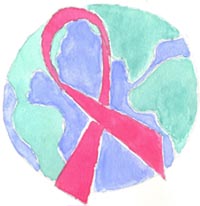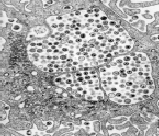Research, Content & CSS coding by: Brandy Gillihan
Please send comments to: Carlos A. Diaz
 The purpose of this page is to raise awareness of the gravity of the AIDS epidemic as well as raise
awareness of World AIDS Day and it's mission. This page is dedicated to providing online governmental,
public, and nonprofit resources regarding World AIDS Day and HIV/AIDS resources in general.
The purpose of this page is to raise awareness of the gravity of the AIDS epidemic as well as raise
awareness of World AIDS Day and it's mission. This page is dedicated to providing online governmental,
public, and nonprofit resources regarding World AIDS Day and HIV/AIDS resources in general.
World AIDS Day was implemented in January of 1988 unanimously by the 140 countries who met at the World Summit of Ministers of Health on AIDS in London of that year.
World AIDS Day image by Keely Ames.
December 1 was declared World AIDS Day by the World Health Organization. Today over 190 countries around the globe observe this day.
According to some statistics, 99% of all infections are in underdeveloped countries. Over 90% of the total people infected globally are not aware that they are infected.
Each year a theme is chosen for World AIDS Day. This year the theme is Women & AIDS. EngenderHealth states, "This year's theme focuses on the risks to women and girls, and on how gender inequality is accelerating the pace of the epidemic."
GlaxoSmith Employee's Human Ribbon
The previous years themes through 2000 are as follows:
- 2008: Stop AIDS. Keep the Promise -- Deliver
- 2007: Stop AIDS. Keep the Promise -- Leadership
- 2006: Stop AIDS. Keep the Promise -- Accountability
- 2005: Stop AIDS. Keep the Promise
- 2004: Women and AIDS
- 2002-2003: Live and Let Live (Stigma & Discrimination)
- 2001: I Care. Do you?
- 2000: AIDS : Men Make A Difference
- More World AIDS Day themes and resources
A Simple Breakdown of HIV and AIDS

AIDS CURE website.
On average, over 10 Billion viruses are created a day in an HIV infected person. As this process continues, the helper T-cells are overrun and can no longer protect the body from opportunistic infections.
The average healthy person has a T-cell count of anywhere from 500-1800. An HIV positive person is diagnosed with AIDS (Acquired ImmuneoDeficiency Syndrome) when their T-cell count is below 200. Even if that person's T-cell count eventually increases to above 200, they will have the same diagonosis.
If you are a person living with HIV or AIDS, it is possible to live a happy, fufilling life. Various medications have been prescribed for persons living with HIV or AIDS with positive results. AIDSinfo, a service of the U.S Department of Health and Human Services, offers research, clinical trials, prevention, and HIV/AIDS treatment information.
If you are a person living with HIV or AIDS and need support, please call the CDC National AIDS Hotline at (800) 342-2437.
For more information about HIV/AIDS transmission, please view the CDC's fact sheet on HIV Transmission.
Preventative Measures

ensure longer life for HIV positive persons.
Image from bbc.co.uk
Sexual Transmission: (This is taken from the CDC's website) "The surest way to avoid transmission of sexually transmitted diseases [including HIV]is to abstain from sexual intercourse, or to be in a long-term mutually monogamous relationship with a partner who has been tested and you know is uninfected...
For persons whose sexual behaviors place them at risk for STDs, correct and consistent use of the male latex condom can reduct the risk of STD transmission. However, no protective method is 100 percent effective."
"Female-to-female transmission of HIV appears to be a rare occurrence. However, case reports of female-to-female transmission of HIV and the well documented risk of female-to-male transmission of HIV indicate that vaginal secretions and menstrual blood are potentially infectious and that mucous membrane (e.g., oral, vaginal) exposure to these secretions have the potential to lead to HIV infection...
condoms should be used consistently and correctly each and every time for sexual contact with men or when using sex toys. Sex toys should not be shared. No barrier methods for use during oral sex have been evaluated as effective by the FDA. However, natural rubber latex sheets, dental dams, cut open condoms, or plastic wrap may offer some protection from contact with body fluids during oral sex and possibly reduce the risk of HIV transmission."
IDU Drugs: (This is taken from the CDC's website) "People who have sex with an injection drug user (IDU) also are at risk for infection through the sexual transmission of HIV. Children born to mothers who contracted HIV through sharing needles or having sex with an IDU may become infected as well.
To minimize the risk of HIV transmission, IDUs must have access to interventions that can help them protect their health. They must be advised to always use sterile injection equipment; warned never to reuse needles, syringes, and other injection equipment; and told that using syringes that have been cleaned with bleach or other disinfectants is not as safe as using new, sterile syringes."
For more information about HIV/AIDS and preventative measures,contact the CDC National Prevention Information Network:
P.O. Box 6003
Rockville, Maryland 20849-6003
1-800-458-5231
The AIDS Quilt and the NAMES Project

The AIDS Quilt originated in the mind of gay rights activist Cleve Jones in San Francisco in 1985. The first panel of the Quilt was created a year later in memory of Jones' friend Marvin Feldman. Out of this initial effort, the NAMES Project Foundation was created, and the AIDS Quilt as it is known today began.
The AIDS Quilt on the National Mall.
Image from
aidsquilt.org
The Quilt was first displayed on October 11, 1987 in Washington D.C. It held 1,920 panels--all representing people who have died of AIDS--and was longer than a football field. To date, 1996 was the last time the Quilt was displayed in its entirety.

